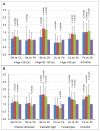Assessing plasma levels of selenium, copper, iron and zinc in patients of Parkinson's disease
- PMID: 24340079
- PMCID: PMC3858355
- DOI: 10.1371/journal.pone.0083060
Assessing plasma levels of selenium, copper, iron and zinc in patients of Parkinson's disease
Abstract
Trace elements have been recognized to play an important role in the development of Parkinson's disease (PD). However, it is difficult to precisely identify the relationship between these elements and the progression of PD because of an insufficient number of patients. In this study, quantifications of selenium (Se), copper (Cu), iron (Fe) and zinc (Zn) by atomic absorption spectrophotometry were performed in plasma from 238 PD patients and 302 controls recruited from eastern China, which is so far the largest cohort of PD patients and controls for measuring plasma levels of these elements. We found that plasma Se and Fe concentrations were significantly increased whereas Cu and Zn concentrations decreased in PD patients as compared with controls. Meanwhile, these four elements displayed differential changes with regard to age. Linear and logistic regression analyses revealed that both Fe and Zn were negatively correlated with age in PD patients. Association analysis suggests that lower plasma Se and Fe levels may reduce the risk for PD, whereas lower plasma Zn is probably a PD risk factor. Finally, a model was generated to predict PD patients based on the plasma concentrations of these four trace elements as well as other features such as sex and age, which achieved an accuracy of 80.97±1.34% using 10-fold cross-validation. In summary, our data provide new insights into the roles of Se, Cu, Fe and Zn in PD progression.
Conflict of interest statement
Figures




References
Publication types
MeSH terms
Substances
LinkOut - more resources
Full Text Sources
Other Literature Sources
Medical

